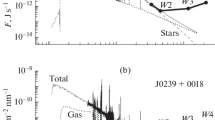Abstract
Results are presented from a detailed spectrophotometric study of a unique system of physically coupled galaxies whose spectra contain identical emission lines. This system consists of four galaxies, three of which have a double or multiple structure in their central portions and are, by definition, galaxies with two or multiple nuclei. Two of these objects are the galaxies with an ultraviolet excess (UVE), Mark 261 and Mark 262, while one is a galaxy made up of two identical starlike nuclei that are referred to as the “twin objects.” In the DSS2 charts, the latter show up as two adjacent stars without any surroundings. However, there are two condensations between these starlike nuclei. The fourth object has a triplet structure. It is shown here that all these objects have the same emission (line) spectra and red shifts. All the physical characteristics that can be determined from the spectra are determined: red shifts, relative intensities of emission lines, their equivalent widths, distances to the galaxies, etc. It is concluded that the members of this system have a common origin, more or less consistent with Ambartsumyan's idea of the fragmentation of an isolated, high density body.
Similar content being viewed by others
REFERENCES
D. Weedman and E. E. Khachikian, Astrofizika 5, 113 (1969).
Yu. Korovyakovskii, A. R. Petrosyan, K. A. Saakyan, and E. E. Khachikyan, Astrofizika 17, 231 (1981).
A. Toomre and J. Toomre, Astrophys. J. 178, 623 (1972).
R. Joseph and G. Wright, Mon. Notic. Roy. Astron. Soc. 214, 87 (1985).
V. A. Ambartsumyan, Izv. AN Arm. SSR, seriya fiz.-mat. nauk 11, 9 (1958).
V. A. Ambartsumyan, S. G. Iskudaryan, R. K. Shakhbazyan, and K. A. Saakyan, Soobshch. Byurakan. observ. 33, 3 (1963).
R. K. Shakhbazyan, Astrofizika 4, 273 (1968).
H. Arp, E. E. Khachikyan, and J. Eidman, Astrofizika 10, 7 (1974).
J. Haidmann and A. T. Kalloghlian, Astrofizika 9, 71 (1973).
B. E. Markaryan, Astrofizika 5, 581 (1969).
T. Page, Astrophys. J. 96, 78 (1942).
L. H. Aller, Gaseous Nebulae, London (1956), p. 66.
G. A. Gurzadyan, Planetary Nebulae [in Russian], Nauka, Moscoow (1962).
E. Ye. Khachikian and D. W. Weedman, Astrophys. J. 164, L109 (1971).
Author information
Authors and Affiliations
Additional information
__________
Translated from Astrofizika, Vol. 48, No. 4, pp. 503–514 (November 2005).
Rights and permissions
About this article
Cite this article
Khachikian, E.Y., Sargsyan, L.A. Spectrophotometric Study of the Region of the Sky Around the Galaxies Markarian 261 and 262. Astrophysics 48, 422–432 (2005). https://doi.org/10.1007/s10511-005-0041-4
Received:
Issue Date:
DOI: https://doi.org/10.1007/s10511-005-0041-4




